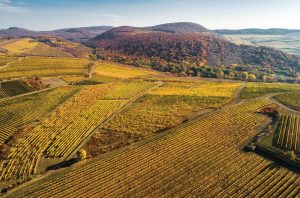[ad_1]
In partnership with Wines of Hungary
Hungary could not have lively volcanoes, however it does have a spectacular volcanic historical past, which continues to form its wines to this present day. The Pannonian Basin, nestled within the Carpathian Mountains, was an space of intense volcanic exercise from shortly after the time of the dinosaurs to just some million years in the past – and also you don’t must journey far in Hungary to seek out volcanic terroir.
What’s a volcanic wine?
Volcanic wine is outlined as that produced from grapes grown on soils derived from volcanic supplies. Since volcanic rocks and ash are extraordinarily various and canopy dozens of nations and areas, to not point out climates and grape varieties, volcanic wines are a big and numerous household.
The topography of many volcanic areas is a problem for vinegrowers, however has produced many sudden advantages. The troublesome terrain – and the truth that phylloxera struggles to outlive in sandy volcanic soils – means uncommon, native grape varieties have been preserved, to not point out conventional farming practices that may be extra acquainted to a Renaissance painter than to most fashionable winemakers.
Volcanic wines thus symbolize a group of extremely distinctive, particular person expressions from all over the world – cussed holdouts in a time of merging flavours and creeping homogeneity. What’s extra, Hungary has a specific abundance of native varieties with singular flavours.

Networks of cool cellars are dug into Hungary’s smooth volcanic rock. Credit score: Wines of Hungary
Savoury vs fruity
What makes volcanic terroirs significantly particular is the mouthwatering high quality their wines all appear to share, whether or not from excessive acid, palpable salinity, or each. This can be as a result of soils’ excessive ranges of the minerals potassium, magnesium, calcium and sodium, all of that are additionally current in wine. Evidently irrespective of the color, volcanic wines are dominated by savoury character. Though they’ve fruit, after all, it’s usually secondary to non-fruity flavours, together with the entire nuances coated by the multi-dimensional time period ‘minerality’.
Minerality and volcanic wines stroll hand in hand. Pink grape examples embrace peppery Kékfrankos and spicy Kadarka; for whites, consider Furmint’s savoury botanical flavours, the summer time flowers of Hárslevelű and the searing stoniness and honeyed character of the uncommon Kéknyelű selection.
Digging into volcanic terroirs
These traits have their roots no less than partly within the soils. Though volcanic soils are extraordinarily various, there are properties shared by many who make them significantly appropriate for high-quality winemaking.
Younger volcanic soils (that’s, these fashioned on current lavas) are sometimes really extra rock than soil. They haven’t but had time to climate into water-retentive clays, as within the higher-elevation vineyards of Tokaj or the Balaton Highlands area. Since low water availability is the one most necessary issue for rising high quality grapes, that is an apparent benefit. Additionally, maybe clearly, the popular volcanic soils for vineyards are often on hillsides, the place gravity ensures that water is restricted. That is significantly true in Hungary.
Counterintuitively, volcanic soils, and particularly the very best ones for vinegrowing, are comparatively infertile. Though lavas typically have beneficiant quantities of crucial macro- and micronutrients required by crops, they don’t seem to be readily accessible. These vitamins should first be weathered into an obtainable type, after which made soluble in water to be taken up by root methods. However water, as we now have simply seen, isn’t usually obtainable, and younger soils usually are not prepared to surrender their vitamins simply but.

The rolling hills of Tokaj conceal a posh geology. Credit score: Wines of Hungary
The style of volcanic terroir
All because of this vines rising on volcanic soils get a broad and balanced food plan, however in small portions: the soils have low fertility however with out explicit deficiencies. This triggers the vines to give attention to ripening fruit reasonably than rising shoots and leaves. Merely put, semi-parched, semi-starved vines produce much less fruit, in smaller bunches, with thicker skins (the supply of a lot of the grapes’ aromas and flavours), leading to extra deeply colored, concentrated, structured and age-worthy wines with a broader vary of flavours.
Very outdated, extremely weathered lavas have the contrasting property of water retention (attributable to excessive ranges of clay), which, when paired with a dry rising season (akin to in Tokaj) retains vines moist and promotes even, regular ripening.
The chemistry of particular volcanic soils, too, has attention-grabbing results because it interacts with totally different grape varieties. Excessive potassium ranges in Badacsony, for instance, permit varieties like Kéknyelü to take up measurably extra potassium than elsewhere, leading to wines with the bizarre mixture of excessive acid, excessive pH and pronounced salinity.
It’s no surprise that lots of Hungary’s best wines are born from these amazingly various volcanic soils, forming a central a part of the story of one of many world’s nice volcanic wine nations.
Uncover extra about Wines of Hungary
Join on
Fb | Instagram | TikTok | Youtube
Learn extra about Hungary’s volcanic wines
Vineyards and volcanics
Tasting Hungary
[ad_2]


